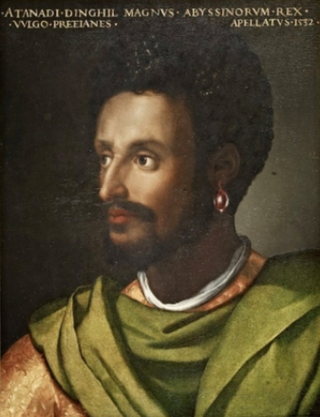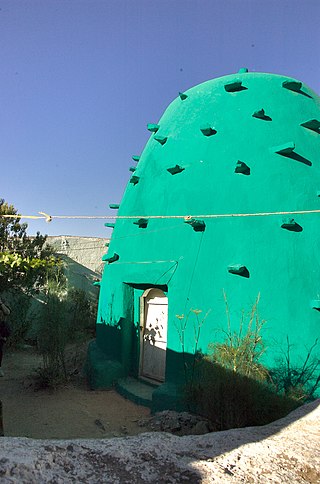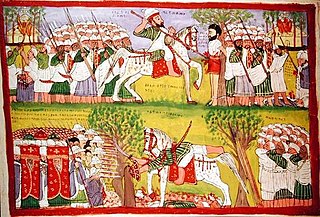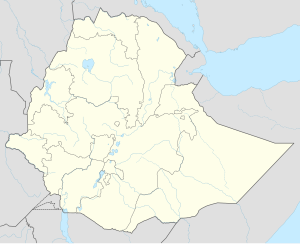
The Adal Sultanate also known as the Adal Empire, or Bar Saʿad dīn was a medieval Sunni Muslim Empire which was located in the Horn of Africa. It was founded by Sabr ad-Din III on the Harar plateau in Adal after the fall of the Sultanate of Ifat. The kingdom flourished c. 1415 to 1577. At its height, the polity under Sultan Badlay controlled the territory stretching from Cape Guardafui in Somalia to the port city of Suakin in Sudan. The Adal Empire maintained a robust commercial and political relationship with the Ottoman Empire. Sultanate of Adal was alternatively known as the federation of Zeila.

Islam is the second-largest religion in Ethiopia behind Christianity, with 31.3 to 35.9 percent of the total population of around 113.5 million people professing the religion as of 2022.

Ahmad ibn Ibrahim al-Ghazi was the Imam of the Adal Sultanate from 1527 to 1543. Imam Ahmad led the conquest of the Ethiopian Empire under the Sultanate of Adal during the Ethiopian-Adal War. He is often referred to as the "King of Zeila" in medieval texts.

The Zagwe dynasty was a medieval Agaw monarchy that ruled the northern parts of Ethiopia and Eritrea. The Agaw are a Cushitic ethnic group native to the northern highlands of Ethiopia and neighboring Eritrea. Centered at Roha, it ruled large parts of the territory from approximately 1137 to 1270 AD, when the last Zagwe King Za-Ilmaknun was killed in battle by the forces of the Amhara King Yekuno Amlak. The Zagwe are most famous for their king Gebre Mesqel Lalibela, who is credited with having constructed the rock-hewn monolithic churches of Lalibela.

Dawit II, also known by the macaronic name Wanag Segad, better known by his birth name Lebna Dengel, was Emperor of Ethiopia from 1508 to 1540, whose political center and palace was in Shewa.
Mahfuz was a Harari Garad, Emir of Harar and Governor of Zeila in the Adal Sultanate. Although he was originally only emir of a small region he would rise to become leader of Adal due to his popularity, wielding more power than the sultan of Adal.He is often known as the "Captain of Zeila" in medieval texts.

Aṣ-ḥamah also spelt as Aṣ-ḥama, was the Negus ruler of the Kingdom of Aksum who reigned from 614–630 C.E.. It is agreed by Muslim scholars that Najashi gave shelter to Muslim emigrants from Mecca, around 615–616 at Axum.

Debre Birhan is a city in central Ethiopia. Located in the Semien Shewa Zone of Amhara Region, about 120 kilometers north east of Addis Ababa on Ethiopian highway 2, the town has an elevation of 2,840 meters, which makes it the highest town of this size in Africa. It was an early capital of Ethiopia and afterwards, with Ankober and Angolalla, was one of the capitals of the kingdom of Shewa. Today, it is the administrative center of the North Shewa Zone of the Amhara Region.
The Battle of Shimbra Kure was fought on 9 March 1529 between the forces of Adal led by Imam Ahmad ibn Ibrahim al-Ghazi, and the Abyssinian army, under Dawit II. It was the first Major battle of the Ethiopian–Adal War

The migration to Abyssinia, also known as the First Hijra, was an episode in the early history of Islam, where the first followers of the Islamic prophet Muhammad migrated from Arabia due to their persecution by the Quraysh, the ruling Arab tribal confederation of Mecca. They sought and were granted refuge in the Kingdom of Aksum, an ancient Christian state that was situated in modern-day Ethiopia and Eritrea, in 9 BH (613 CE) or 7 BH (615 CE). The ruling Aksumite monarch who received them is known in Islamic sources as Najashi, the Negus of the kingdom; modern historians have alternatively identified him with the Aksumite king Armah and Ella Tsaham. Some of the Sahabah exiles returned to Mecca and made the migration to Medina with Muhammad, while the others remained in Aksum and arrived in Medina in 628.
Afro-Arabs or African Arabs are Arabs of full or partial indigenous African descent. These include primarily minority groups in the United Arab Emirates, Yemen, Saudi Arabia, Oman, and Qatar, as well as Syria, Iraq, Palestine, and Jordan. The term may also refer to various Arab groups in certain African regions.

Religion in Ethiopia consists of a number of faiths. Among these mainly Abrahamic religions, the most numerous is Christianity totaling at 67.3%, followed by Islam at 31.3%. There is also a longstanding but small Ethiopian Jewish community. Some adherents of the Baháʼí Faith likewise exist in a number of urban and rural areas. Additionally, there is also a substantial population of the adherents of traditional faiths.

Nur al-Din or Nur ibn Mujahidibn ‘Ali ibn ‘Abdullah al Dhuhi Suha was a Somali Emir of Harar who ruled over the Adal Sultanate. He was known for marrying his uncle's widow, Bati del Wambara, and he also succeeded Imam Ahmad as leader of the Muslim forces fighting Christian Ethiopia. He is often known as the "King of Adel" in medieval texts.

The Ethiopian–Adal War or Abyssinian–Adal War, also known in Arabic as the "Futuḥ al-Ḥabash", was a military conflict between the Christian Ethiopian Empire and the Muslim Adal Sultanate from 1529 to 1543. The Christian Ethiopian troops consisted of the Amhara, Tigrayans, Tigrinya and Agaw people, and at the closing of the war, supported by a few hundred Portuguese musketmen. Whereas Adal forces were mainly comprised of Harla, Somali, Afar, as well as Arab and Turkish gunmen. Both sides at times would see the Maya mercenaries join their ranks.
The Harla, also known as Harala, Haralla are an ethnic group that once inhabited Ethiopia, Somalia, and Djibouti. They spoke the now-extinct Harla language, which belonged to either the Cushitic or Semitic branches of the Afroasiatic family.
Ga'ewa or Ga‘ǝwa was a Muslim regent in the north of the Horn of Africa in the sixteenth century. Her kingdom stretched from Metemma in the west to the area south of the Mareb river in the Ethiopian province of Tigray.
A Malassay was a member of the elite infantry units that formed the Adal Sultanate's household troops. According to Manfred Kropp, Malassay were the Harari armed forces.

Al Nejashi Mosque is a mosque in Negash, in the Tigray Region of Ethiopia.
Abu Bakr "the Slim" (Qaṭin) also known simply as Qaṭin sometimes spelt Qecchin or Katchthcen was a general in the Adal Sultanate under Ahmad ibn Ibrahim al-Ghazi. Abubaker's sobriquet "Qaṭin" is derived from the Harari term for "thin". He was the Garad of Hubat.
Abbas ibn Abun ibn Ibrahim also known as Wazir Abbas was an Adalite General who became Grand Vizier of the Adal Sultanate in 1535. The nephew of Ahmed Gurey, he led the Adalite conquest of Medri Bahri and was briefly the Bahr Negash. He was also the father of the Sultan Talha ibn Abbas.













